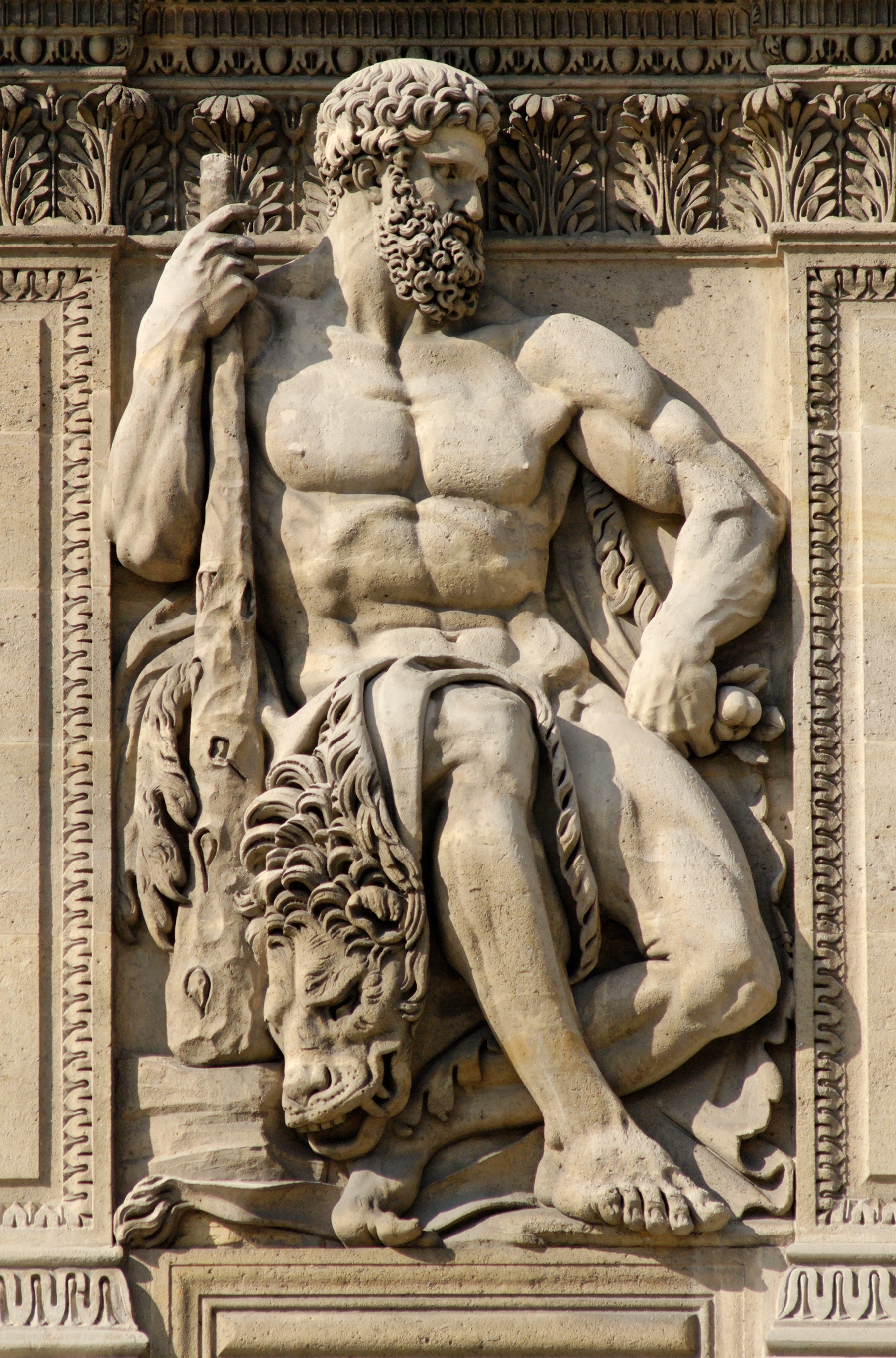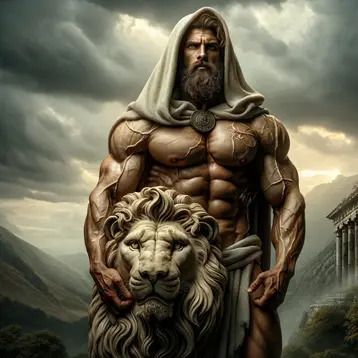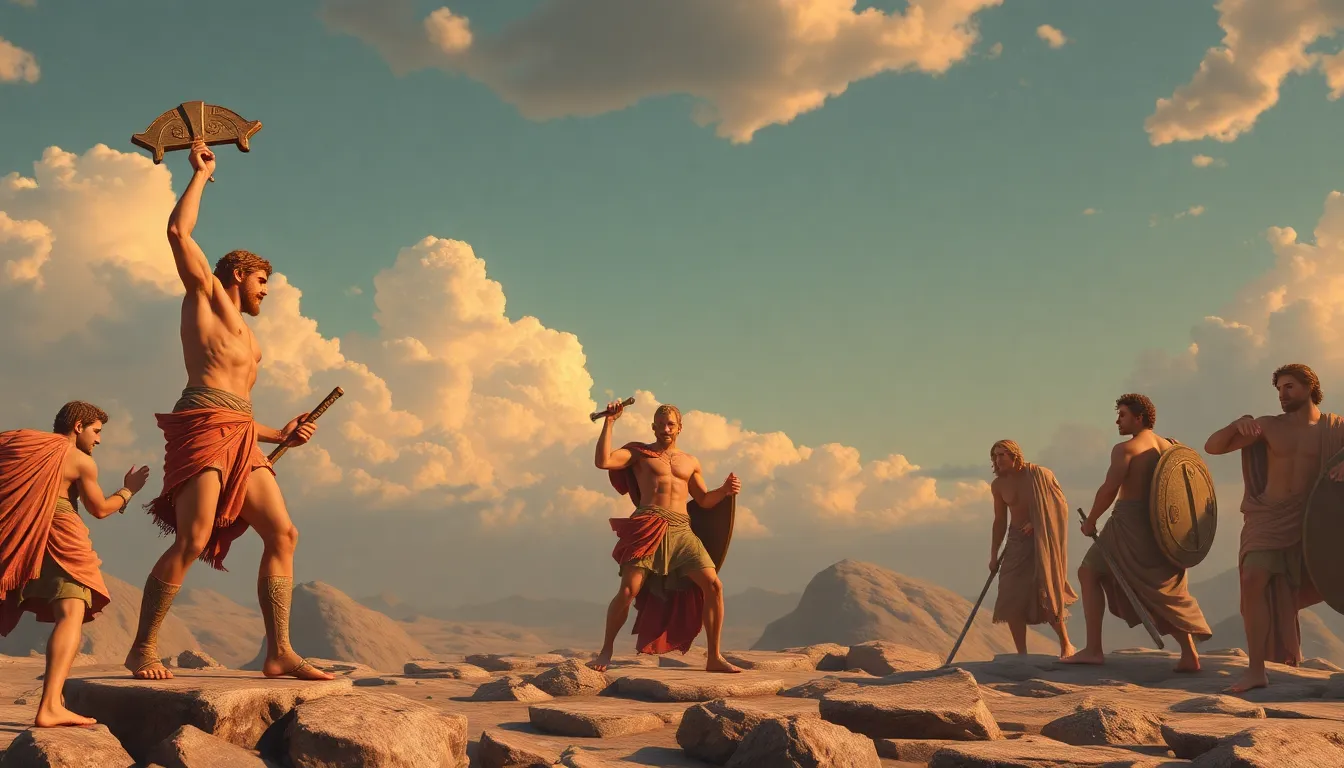The Legendary Heracles: A Mythological Icon of Strength and Resilience
In the annals of Greek mythology, few figures loom as large as Heracles, the demigod whose tales of heroism and enduring strength have captivated minds for millennia. Known to the Romans as Hercules, Heracles embodies the quintessential mythological hero, famed for his extraordinary birth, unyielding spirit, and the legendary Twelve Labors. This article delves into the life and exploits of Heracles, exploring the intricate tapestry of myths that surround this larger-than-life figure.
The Divine Birth and Early Life of Heracles
Heracles's story begins with his divine parentage. He was the son of Zeus, the king of the Olympian gods, and Alcmene, a mortal woman of unparalleled beauty and virtue. Zeus, known for his amorous escapades, desired Alcmene and, assuming the form of her husband, Amphitryon, he visited her. The result of this divine union was Heracles, whose very name means "glory of Hera," despite the goddess Hera's infamous wrath towards him.
Hera, incensed by Zeus's infidelity, harbored a deep-seated hatred for Heracles from the moment of his birth. She sent two serpents to kill the infant Heracles in his crib, but displaying his superhuman strength from an early age, Heracles strangled the snakes, foreshadowing the incredible feats yet to come. This incident marked the beginning of a life characterized by great challenges and triumphs.
The Madness of Heracles and the Path to Redemption
As Heracles grew, he became known for his exceptional strength and bravery, mastering the arts of warfare under the tutelage of many formidable mentors. However, his life took a dark turn due to the machinations of Hera. In a fit of madness induced by the vengeful goddess, Heracles tragically killed his wife, Megara, and their children. Overwhelmed by guilt and despair, he sought purification and redemption.
To atone for his sins, the oracle of Delphi advised Heracles to serve King Eurystheus, who imposed upon him a series of formidable tasks known as the Twelve Labors. These labors were designed to be impossible challenges, but Heracles, driven by a need for penance and to regain honor, embarked on these quests with unmatched determination.
The Formidable Twelve Labors
Heracles's Twelve Labors represent some of the most iconic stories in Greek mythology, each labor more daunting than the last. They are a testament to his indomitable spirit and exceptional prowess:
1. **The Nemean Lion* Heracles was tasked with slaying the invincible Nemean Lion, a fearsome beast whose hide could not be penetrated by weapons. Using his immense strength, Heracles strangled the lion, later wearing its impenetrable skin as armor.
2. **The Lernaean Hydra* The Hydra, a multi-headed serpent, posed a deadly threat as it regrew two heads for every one severed. With the help of his nephew Iolaus, Heracles cauterized the necks after decapitation, ultimately defeating the monster and dipping his arrows in its toxic blood.
3. **The Ceryneian Hind* This labor required Heracles to capture the sacred golden-horned hind of Artemis without causing it harm. After a year's pursuit, he gently apprehended the creature, demonstrating not only strength but cunning and patience.
4. **The Erymanthian Boar* Heracles was tasked with capturing the ferocious Erymanthian Boar alive. Using his wits, he drove the boar into thick snow, effectively subduing the beast and transporting it to King Eurystheus.
5. **The Augean Stables* Known for its dirty stables filled with immortal cattle, cleaning them seemed impossible. However, Heracles ingeniously rerouted two rivers to wash out the filth, completing the task in a single day.
6. **The Stymphalian Birds* These man-eating birds with metallic feathers plagued the region of Stymphalia. Heracles frightened them into the air with a rattle given by Athena and shot many down with his arrows.
These first six labors showcased Heracles's strength, intelligence, and ability to overcome devious challenges. Each task brought him closer to redemption, and his heroics earned him admiration and respect across Greece.
The legacy of Heracles is a complex tapestry woven with threads of heroism, tragedy, and redemption. As much as his labors stand as tales of might and valor, they serve as lessons in humility and resilience. In the epic saga of Heracles, we find enduring truths about the human condition, encapsulated in the myth of a demigod whose feats echoed through time, inspiring countless generations.
The Concluding Six Labors
The second half of Heracles’s Twelve Labors further illustrates not only his incredible physical strength but also his strategic mind and perseverance in the face of seemingly insurmountable challenges. These tasks demanded creativity, willpower, and sometimes divine assistance, emphasizing Heracles’s multidimensional heroism.
7. **The Cretan Bull* Heracles was sent to capture the fearsome Cretan Bull that had been terrorizing the island of Crete. This bull was the very creature that fathered the Minotaur. Undeterred by its raging power, Heracles wrestled it into submission and brought it back to King Eurystheus, who released it into the wild, only for it later to be killed by Theseus.
8. **The Mares of Diomedes* These were not ordinary mares, for they were flesh-eating horses belonging to the Thracian king Diomedes. Heracles not only had to capture these ferocious creatures but also stop their brutal appetite. Demonstrating both cunning and might, Heracles tamed the beasts by feeding them their owner, Diomedes, before bringing them back to his king.
9. **The Belt of Hippolyta* The ninth labor involved obtaining the girdle of Hippolyta, queen of the Amazons. Unlike the beasts and monsters he previously faced, this task involved diplomacy and persuasion. Initially, Hippolyta willingly offered the belt to Heracles, charmed by his reputation. However, Hera, perpetually scheming against him, incited the Amazons to attack him. A tragic misunderstanding ensued, leading to conflict and Heracles ultimately taking the belt by force.
10. **The Cattle of Geryon* Heracles’s tenth labor took him to the far reaches of the known world, where he had to steal the cattle of the giant Geryon, a fearsome foe with three bodies. To complete this labor, Heracles had to first tackle formidable obstacles, including the clever watchdog Orthrus and the herdsman Eurytion. Brandishing his bow and further strengthened by a cup borrowed from Helios, Heracles vanquished Geryon in a climactic battle.
11. **The Apples of the Hesperides* This labor required Heracles to obtain golden apples from the sacred garden of the Hesperides, guarded by the dragon Ladon. In his quest, Heracles exhibited not only physical prowess but also cleverness. He sought counsel from the sea god Nereus and even enlisted the help of Atlas, tricking him into retrieving the apples by momentarily taking on the weight of the world.
12. **The Capture of Cerberus* The final labor saw Heracles descend into the Underworld itself to capture Cerberus, the three-headed watchdog of Hades. This symbolic task mirrored his confrontation with death and the unknown. After gaining Hades’ permission, Heracles used his bare hands to subdue the monstrous hound, safely bringing it to Eurystheus before returning it to the dark realm, thus proving his triumph over mortal limitations.
Heracles's Influence in Classical Culture
Through these labors, Heracles endeared himself to the Greek people as an archetype of human achievement against overwhelming odds. His tales were not only integral to ancient Greek literature but also played a crucial role in the cultural and political landscape. Temples were dedicated to him, and his exploits were celebrated in art, statues, and pottery.
Heracles’s stories also touched on political propaganda. Greek city-states frequently aligned themselves with his legacy, embellishing local legends to claim descent from him or to demonstrate favor with the gods. Festivals like the Herakleia in Athens honored his mythic deeds, strengthening civic identity and religious devotion.
Another significant aspect of Heracles’s mythology is his portrayal as a divine protector. His universal appeal and embodiment of virtue and strength made him a popular figure in various heroic cults across the Mediterranean. In many ways, Heracles was not just a hero of antiquity; he was also a divine figure that resonated with the struggles and aspirations of humanity.
Heracles’s Mortal Legacy and Immortal Ascension
The saga of Heracles did not end with his labors. Though ultimately destined for immortality, his mortal life remained fraught with trials and tribulations. Heracles went on to experience love, jealousy, and betrayal, all of which culminated in his tragic demise. The story of his death further humanizes the hero, illustrating that despite his divine heritage, he was not immune to the forces of love and vengeance.
Deianeira, his second wife, unwittingly caused Heracles’s demise. Fearing she was losing his love, she gave him a robe smeared with what she thought was a love potion, but was, in fact, tainted with the venom of the Hydra. The poison burned Heracles's flesh, leading him to construct his own funeral pyre. Yet, in death, Heracles was not entirely defeated.
According to myth, upon his death, Heracles achieved immortality. His mortal sufferings came to an end, and he was granted a place among the gods on Mount Olympus. There, he reconciled with Hera, who had tormented him throughout his life, marking a symbolic release from his earthly burdens. Thus, Heracles transcended his mortal trials, joining the pantheon of immortal beings.
As a timeless figure whose legends continue to resonate, Heracles remains a paragon of resilience and perseverance, embodying the eternal struggle to overcome adversity. Through his stories, generations have found inspiration and learned that true heroism lies not only in strength and power but also in endurance and moral fortitude.
The Psychological and Symbolic Dimensions of Heracles
Heracles's myth, rich with physical feats and daring adventures, also invites a more profound psychological interpretation. His character embodies the universal human experience, characterized by internal and external battles, growth, and the quest for meaning. Psychologically, Heracles represents the inner journey each individual undergoes — a struggle against personal demons, the pursuit of redemption, and ultimately, the aspiration for a higher purpose.
The Twelve Labors of Heracles can be viewed as allegories for psychological trials. They symbolize the challenges people face in their journey toward self-actualization and introspection. Heracles’s constant confrontations with monstrous creatures and divine punishments serve as metaphors for the trials encountered within the human psyche. The overcoming of each labor reflects personal growth and the shedding of previous limitations, culminating in his acceptance among the gods.
Moreover, the duality of Heracles’s existence as both a mortal and a demigod echoes the tension between human fragilities and the aspirational drive toward something greater than oneself. This duality finds resonance in modern narratives, where characters frequently straddle the line between human vulnerability and transcendent potential.
Heracles in Modern Culture and Interpretations
The mythology of Heracles has transcended ancient Greek civilization and penetrated deeply into the fabric of modern culture. His stories have been retold and reimagined countless times in literature, art, and popular media. These reinventions reveal much about the enduring nature of his legend and its adaptable symbolism.
One of Heracles’s most significant cultural impacts is seen in literary adaptations. Writers from the Renaissance to contemporary times have drawn inspiration from his legacy, using his myth to explore themes of heroism, struggle, morality, and the human condition. From the plays of Euripides and Seneca to modern novels and graphic novels, Heracles’s story continues to be a fertile ground for exploring timeless human themes.
In the realm of popular media, Heracles's influence is unmistakable. Whether through animated films, television series, or blockbuster movies, his stories find new life, introducing him to audiences far removed from the ancient world. These adaptations often highlight his unmatched strength and resilience, while also exploring his vulnerabilities and moral dilemmas, emphasizing his relevance to contemporary society.
Beyond entertainment, Heracles serves as a symbol in philosophical and psychological discourses. His myth is frequently cited in discussions of the hero’s journey, a narrative template popularized by Joseph Campbell, which outlines a hero's adventure, personal transformation, and return to society with newfound wisdom. Heracles embodies this journey, making him an archetype for exploring the human capacity for growth and evolution.
The Enduring Legacy of Heracles
Heracles, a figure intertwined with historical, cultural, and psychological threads, continues to captivate and inspire. His mythological narrative is a powerful reminder of humanity's capacity to rise above adversity, seek redemption, and aspire to transcendence. His labors reflect the complex journey of the human spirit, triumphing over personal trials and societal expectations through strength, intelligence, and courage.
Heracles’s legacy resonates not only in individual pursuits but also in collective values. He represents the virtues of bravery, perseverance, and the pursuit of justice, qualities that are timeless in their appeal and relevance. His story reminds us that true heroism is not merely a matter of physical prowess but involves a deep commitment to overcoming personal flaws and external obstacles.
In an era where myths are constantly being reinterpreted, Heracles stands firm as a testament to human resilience. His narrative is a testament to the enduring power of storytelling in shaping cultural, moral, and existential discourse. Through his adventures and misadventures, Heracles invites us to consider our own journeys, encouraging us to confront our challenges with the same valor and determination that have immortalized him as one of mythology’s most enduring heroes.
As we reflect on Heracles’s myth, we are reminded that the dreams of ancient Greece are not so different from those of today. In the figure of Heracles, we see an embodiment of our quest for meaning, strength, and purpose, a brave reminder that amidst the trials of life, the spirit of the hero lives on in each of us.








Comments